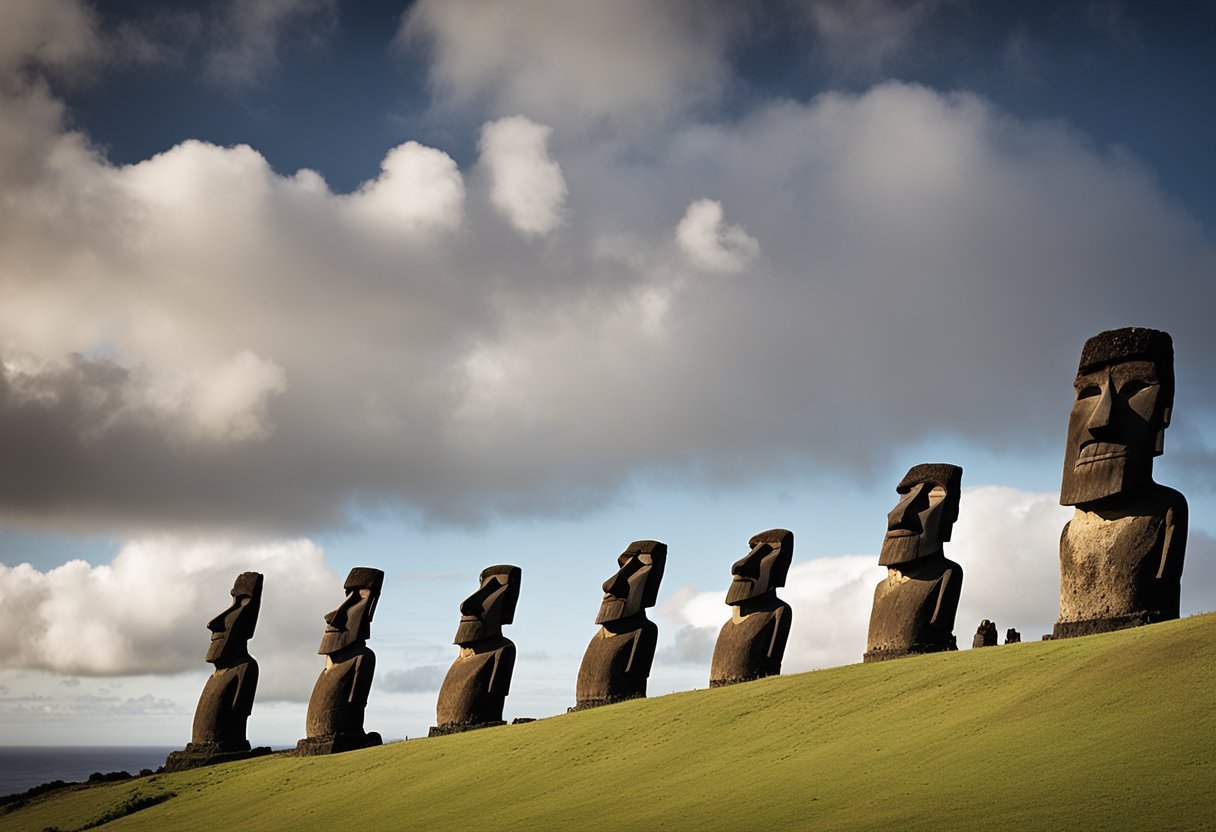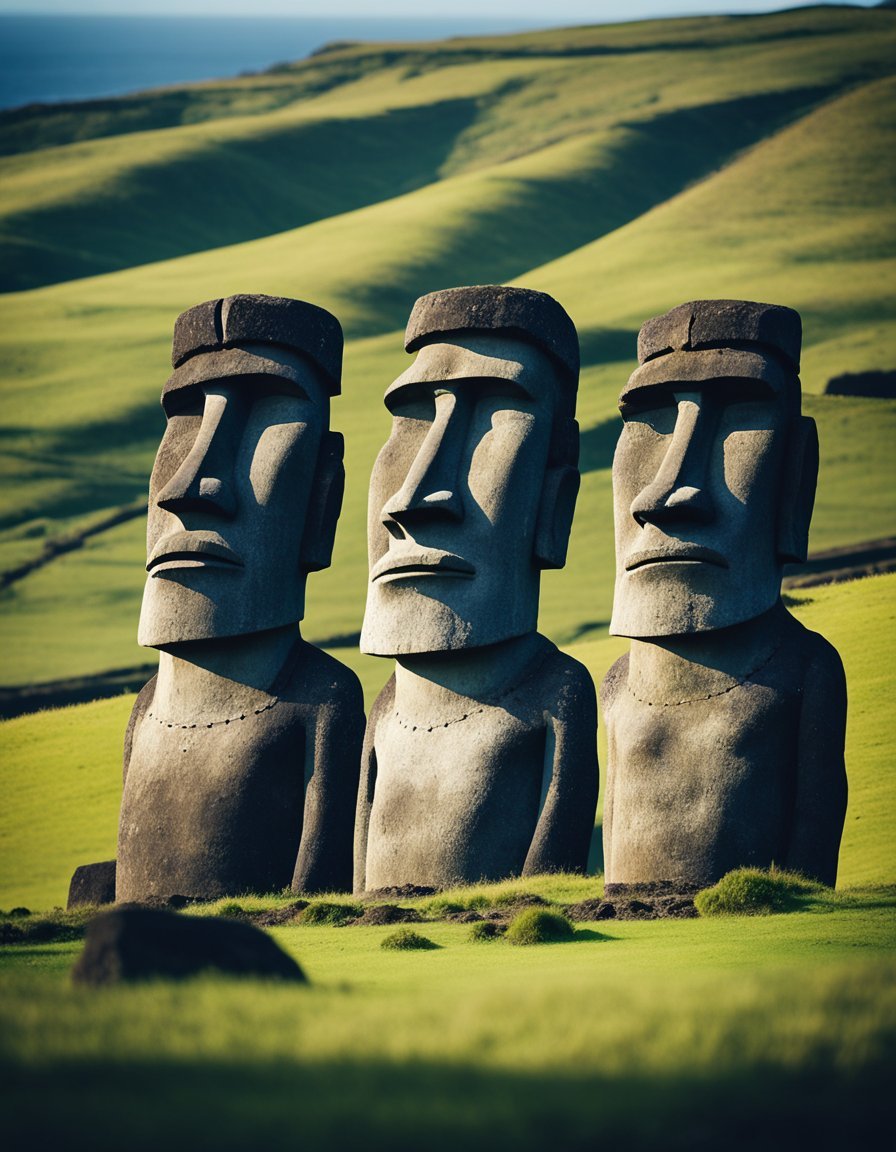Easter Island, known to its native inhabitants as Rapa Nui, holds one of the most fascinating archaeological mysteries in the world – the Moai statues. These iconic stone figures, carved from volcanic tuff, are more than just impressive monuments. They stand as silent witnesses to the history, culture, and beliefs of the Rapa Nui people.
The Moai were probably carved to commemorate important ancestors, serving as a physical embodiment of those who once walked the island. Each statue, with its distinct Polynesian features, reflects the craftsmanship and spiritual significance attributed to these ancestors.
Recent events have shown how vulnerable these heritage sites are, such as the devastating fire that caused irreparable damage to hundreds of Moai. Despite these challenges, the Moai continue to be a subject of intrigue and reverence, offering a glimpse into the deep cultural roots of Easter Island.
Historical Significance

The historical significance of the Moai statues on Easter Island is vast, spanning from their intricate construction methods to their deep cultural symbolism and potential astronomical purposes.
Construction and Carving
The construction and carving of the Moai statues showcase the exceptional craftsmanship of the Rapa Nui people. Volcanic tuff, a light, porous material extracted from quarries, was the primary material used. Artisans meticulously chiseled each statue directly from the quarry walls before transporting them across the island. Tools made of harder stone like basalt were utilized to refine the statues’ features, including the prominent heads and faces. The largest Moai, known as Paro, stands around 33 feet tall and weighs approximately 82 tons. The sheer scale and precision of these efforts highlight the advanced skills and organized labor force of the island’s ancient inhabitants.
Cultural Symbolism
The Moai statues are believed to represent important ancestors of the Rapa Nui people. Facing inland, they watch over the villages, possibly serving a protective role. These statues carry significant spiritual meaning, often associated with the notion of mana, or sacred spiritual energy. Their placement and alignment on ceremonial platforms, known as ahu, suggest they played a central role in community rituals and social governance. The expression and posture of each Moai may represent particular individuals of high status, further emphasizing their importance in upholding familial and societal connections.
Astronomical Alignment Theories
Some theories propose that the positioning of the Moai statues may be linked to astronomical events and celestial navigation. Scholars have observed potential alignments with the solstices and equinoxes, suggesting the Rapa Nui people used these statues to mark important astronomical occurrences. This theory posits that the Moai’s orientation could have helped in agricultural planning and maintaining the calendar. While the evidence remains debated, these ideas highlight the complex understanding of astronomy that might have influenced the islanders’ decision-making processes.
Contemporary Perspectives

Modern discussions about the Moai statues are heavily influenced by efforts to preserve these ancient artifacts, their impact on local tourism and the economy, and ongoing research aimed at unlocking their mysteries. Each angle provides insight into how these ancient statues continue to shape the present.
Conservation Efforts
Efforts to conserve the Moai statues are crucial as natural elements and human activities pose severe threats. Volcanic tuff material is highly susceptible to erosion. Recent wildfires in Rapa Nui have caused “irreparable” damage to several statues.
Local and international partnerships drive conservation initiatives. Special coatings and shelters have been applied to protect the statues from further weathering. Preventing tree roots from damaging the statues’ foundations is another component of these efforts.
Community involvement is also integral. Rapa Nui inhabitants are deeply invested in preserving their cultural heritage. Workshops and training programs help locals learn conservation techniques, fostering a sense of stewardship.
Tourism and Economy
Tourism is a lifeline for Easter Island’s economy. Moai statues draw visitors from around the world, boosting local businesses. Hotels, restaurants, and tours provide jobs for many island residents.
Entrance fees and guided tours generate significant revenue. However, mass tourism presents challenges like the environmental impact and potential damage to the statues. There’s an ongoing balancing act between welcoming tourists and preserving the island’s integrity.
Sustainable tourism initiatives aim to mitigate these concerns. Regulations limit the number of visitors to protect the statues and local ecosystem. Educational programs inform tourists about the importance of respecting cultural heritage and natural surroundings.
Research and Study
Continuous research sheds light on the historical context of the Moai statues. Scholars study their construction methods, suggesting the use of simple tools and a collaborative effort among the island’s inhabitants. Carving out of volcanic tuff, transporting, and erecting these massive figures remains an area of active inquiry.
Genetic studies and archaeological digs provide insights into the ancient Polynesians who created these statues. Researchers analyze remnants found at dig sites to understand social structures, diet, and lifestyle.
Technological advancements like 3D scanning and ground-penetrating radar offer deeper analyses without physical intrusion. Such technology helps map the island and predict where new archaeological sites might be located.

